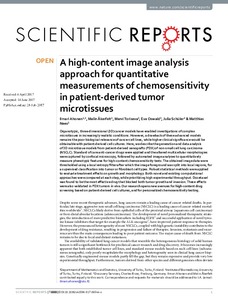A high-content image analysis approach for quantitative measurements of chemosensitivity in patient-derived tumor microtissues
Akerfelt M; Oswald E; Ahonen I; Schuler J; Toriseva M; Nees M
A high-content image analysis approach for quantitative measurements of chemosensitivity in patient-derived tumor microtissues
Akerfelt M
Oswald E
Ahonen I
Schuler J
Toriseva M
Nees M
NATURE PUBLISHING GROUP
Julkaisun pysyvä osoite on:
https://urn.fi/URN:NBN:fi-fe2021042717063
https://urn.fi/URN:NBN:fi-fe2021042717063
Tiivistelmä
Organotypic, three-dimensional (3D) cancer models have enabled investigations of complex microtissues in increasingly realistic conditions. However, a drawback of these advanced models remains the poor biological relevance of cancer cell lines, while higher clinical significance would be obtainable with patient-derived cell cultures. Here, we describe the generation and data analysis of 3D microtissue models from patient-derived xenografts (PDX) of non-small cell lung carcinoma (NSCLC). Standard of care anti-cancer drugs were applied and the altered multicellular morphologies were captured by confocal microscopy, followed by automated image analyses to quantitatively measure phenotypic features for high-content chemosensitivity tests. The obtained image data were thresholded using a local entropy filter after which the image foreground was split into local regions, for a supervised classification into tumor or fibroblast cell types. Robust statistical methods were applied to evaluate treatment effects on growth and morphology. Both novel and existing computational approaches were compared at each step, while prioritizing high experimental throughput. Docetaxel was found to be the most effective drug that blocked both tumor growth and invasion. These effects were also validated in PDX tumors in vivo. Our research opens new avenues for high-content drug screening based on patient-derived cell cultures, and for personalized chemosensitivity testing.
Kokoelmat
- Rinnakkaistallenteet [19207]
